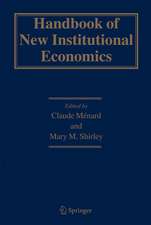Empirical Vector Autoregressive Modeling: Lecture Notes in Economics and Mathematical Systems, cartea 407
Autor Marius Oomsen Limba Engleză Paperback – 28 mar 1994
Din seria Lecture Notes in Economics and Mathematical Systems
-
 Preț: 360.02 lei
Preț: 360.02 lei -
 Preț: 383.93 lei
Preț: 383.93 lei - 15%
 Preț: 693.39 lei
Preț: 693.39 lei -
 Preț: 384.09 lei
Preț: 384.09 lei -
 Preț: 380.07 lei
Preț: 380.07 lei -
 Preț: 446.26 lei
Preț: 446.26 lei -
 Preț: 497.37 lei
Preț: 497.37 lei -
 Preț: 380.84 lei
Preț: 380.84 lei -
 Preț: 384.86 lei
Preț: 384.86 lei -
 Preț: 378.34 lei
Preț: 378.34 lei -
 Preț: 399.67 lei
Preț: 399.67 lei - 20%
 Preț: 360.93 lei
Preț: 360.93 lei - 15%
 Preț: 643.16 lei
Preț: 643.16 lei -
 Preț: 379.09 lei
Preț: 379.09 lei -
 Preț: 404.76 lei
Preț: 404.76 lei -
 Preț: 385.62 lei
Preț: 385.62 lei - 15%
 Preț: 644.49 lei
Preț: 644.49 lei -
 Preț: 379.09 lei
Preț: 379.09 lei -
 Preț: 345.50 lei
Preț: 345.50 lei -
 Preț: 425.80 lei
Preț: 425.80 lei -
 Preț: 378.34 lei
Preț: 378.34 lei - 18%
 Preț: 775.65 lei
Preț: 775.65 lei -
 Preț: 392.60 lei
Preț: 392.60 lei -
 Preț: 401.61 lei
Preț: 401.61 lei - 15%
 Preț: 646.43 lei
Preț: 646.43 lei -
 Preț: 382.18 lei
Preț: 382.18 lei -
 Preț: 378.34 lei
Preț: 378.34 lei - 15%
 Preț: 637.59 lei
Preț: 637.59 lei - 15%
 Preț: 647.27 lei
Preț: 647.27 lei -
 Preț: 377.73 lei
Preț: 377.73 lei -
 Preț: 447.84 lei
Preț: 447.84 lei - 15%
 Preț: 644.49 lei
Preț: 644.49 lei -
 Preț: 386.00 lei
Preț: 386.00 lei - 15%
 Preț: 654.43 lei
Preț: 654.43 lei -
 Preț: 415.02 lei
Preț: 415.02 lei -
 Preț: 411.54 lei
Preț: 411.54 lei -
 Preț: 398.92 lei
Preț: 398.92 lei -
 Preț: 398.92 lei
Preț: 398.92 lei -
 Preț: 392.75 lei
Preț: 392.75 lei - 15%
 Preț: 635.47 lei
Preț: 635.47 lei - 20%
 Preț: 653.56 lei
Preț: 653.56 lei -
 Preț: 379.86 lei
Preț: 379.86 lei -
 Preț: 495.46 lei
Preț: 495.46 lei -
 Preț: 447.99 lei
Preț: 447.99 lei -
 Preț: 378.71 lei
Preț: 378.71 lei - 15%
 Preț: 637.13 lei
Preț: 637.13 lei -
 Preț: 385.84 lei
Preț: 385.84 lei -
 Preț: 378.54 lei
Preț: 378.54 lei - 15%
 Preț: 666.55 lei
Preț: 666.55 lei
Preț: 645.60 lei
Preț vechi: 759.54 lei
-15% Nou
Puncte Express: 968
Preț estimativ în valută:
123.54€ • 132.10$ • 103.00£
123.54€ • 132.10$ • 103.00£
Carte tipărită la comandă
Livrare economică 17 aprilie-01 mai
Preluare comenzi: 021 569.72.76
Specificații
ISBN-13: 9783540577072
ISBN-10: 3540577076
Pagini: 404
Ilustrații: XIII, 382 p.
Dimensiuni: 155 x 235 x 21 mm
Greutate: 0.56 kg
Ediția:Softcover reprint of the original 1st ed. 1994
Editura: Springer Berlin, Heidelberg
Colecția Springer
Seria Lecture Notes in Economics and Mathematical Systems
Locul publicării:Berlin, Heidelberg, Germany
ISBN-10: 3540577076
Pagini: 404
Ilustrații: XIII, 382 p.
Dimensiuni: 155 x 235 x 21 mm
Greutate: 0.56 kg
Ediția:Softcover reprint of the original 1st ed. 1994
Editura: Springer Berlin, Heidelberg
Colecția Springer
Seria Lecture Notes in Economics and Mathematical Systems
Locul publicării:Berlin, Heidelberg, Germany
Public țintă
ResearchCuprins
1 Introduction.- 1.1 Integrating results.- 1.2 Goal of the study.- 1.3 Data and measurement model.- 1.4 Baseline model and methodology.- 1.5 Outline of the study.- 1.6 What is new?.- 2 The Unrestricted VAR and its components.- 2.1 Introduction.- 2.2 The model.- 2.3 Univariate processes and unit roots.- 2.4 Integrated processes.- 2.5 Alternative models for nonstationarity, long memory and persistence.- Appendix A2.1 MA representation integrated process.- Appendix A2.2 Univariate testing for unit root nonstationarity.- 3 Data Analysis by Vector Autoregression.- 3.1 Introduction.- 3.2 Data-oriented measures of influence.- 3.3 Diagnostic checking.- Appendix A3.1 Influence measures for the normal linear model.- Appendix A3.2 Influence measures for the multivariate general linear model.- Appendix A3.3 Influence measures in principal component analysis.- 4 Seasonality.- 4.1 Introduction.- 4.2 Application of the idea of unobserved components.- 4.3 Application of linear filters to estimate unobserved components.- 4.4 Data analysis of the seasonal component.- 4.5 Application of the Census X-11 filter in a VAR.- Appendix 4.1 Trigonometric seasonal processes in regression.- Appendix 4.2 Backforecasts and deterministic changes in mean.- 5 Outliers.- 5.1 Introduction.- 5.2 The outlier model.- 5.3 Some effects of outliers on VAR estimates.- 5.4 Derivation of the LM-statistics.- 5.5 An artificial example.- 5.6 Application to macroeconomic series.- 5.7 Two simple ways to study the influence of outliers.- Appendix 5.1 Some proofs concerning outlier test statistics.- Appendix 5.2 Subsample analysis outlier influence.- Appendix 5.3 Robust estimation by extraction of additive outliers.- 6 Restrictions on the VAR.- 6.1 Introduction.- 6.2 Cointegration, the number of unit roots, and common trends.- 6.3 Straightforward transformation formulae.- 6.4 Trend stationary processes and quadratic trends.- 6.5 Estimating pushing trends and pulling equilibria.- 6.6 Multivariate tests for unit roots.- Appendix 6.1 Computation and distribution multivariate unit root test statistics.- 7 Applied VAR Analysis for Aggregate Investment.- 7.1 Introduction.- 7.2 The variable of interest and some of its supposed relationships.- 7.3 Measurement model.- 7.4 Univariate analysis.- 7.5 Multivariate analysis.- Appendix 7.1 Data sources and construction.- Appendix 7.2 Results of final VECM model.- Appendix 7.3 Open economy stochastic dynamic general equilibrium models.- Summary.- References.- Name index.














